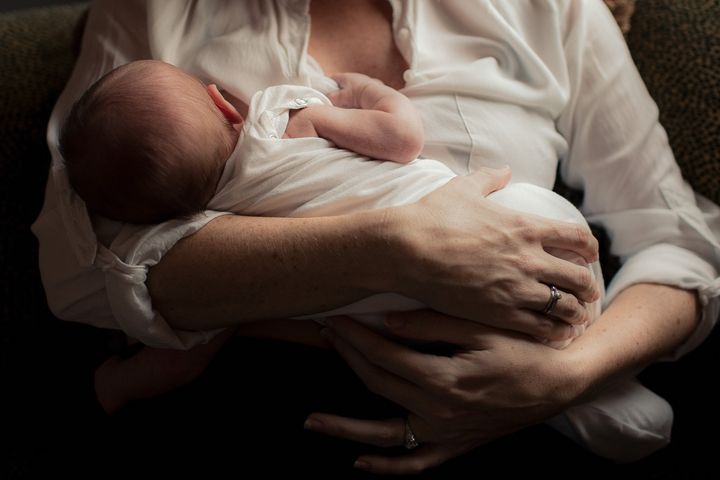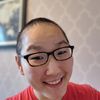
I was 34 weeks pregnant with my second son and had already started lactating on my right side when I first noticed a lump in my right breast.
While breastfeeding my first son, who was 2 and a half years old by this point, my right breast was my hero boob. (My left breast ― “zero boob”― produced much less milk the first time around.) But my right side had also developed a clogged duct that turned into an abscess while I was breastfeeding him, and when I noticed a hard spot in the same area around this time, I figured I was dealing with a similar issue.
I talked to one of my OBGYNs that week, wondering if it was possible to have a clogged duct while still pregnant. I also had a lump in my right armpit, similar to one I’d developed when my milk came in after baby number one. This doctor, and several others on my OBGYN team, ended up dismissing my lumps. After all, I was 34 years old, 34 weeks pregnant, and I had veteran breastfeeding boobs. All of the doctors concluded that my symptoms were due to lactation issues.
I was relieved to be able to dismiss my lumps, since I had a very active 2-year-old who I was trying to potty train, an intense full-time job, and was living abroad in Seoul, South Korea, with no family or close friends around other than my husband.
Fast forward to six weeks postpartum. My second son was breastfeeding beautifully ― nothing compared to the difficulties I’d had with my first son. Both breasts were producing milk (though, as expected, my right hero boob was producing more).
My second son was gaining weight like a champ, but the pesky clogged duct in my right breast had not gone away, and the lump in my right armpit had grown to the size of a tennis ball and started to hurt. I scheduled an appointment with a lactation consultant through a natural birthing center in the Gangnam district of the city (yes, that Gangnam).
Although I’m ethnically Korean, I am a Korean American adoptee and speak hardly any Korean. In fact, the only useful phrase I was able to pick up while I lived in South Korea was, “I don’t speak Korean.” I had to speak to the lactation consultant through an interpreter, meaning our discussion was stilted and awkward and I didn’t truly know if my questions were getting through or if the answers I got were being translated correctly. She, like my OBGYN, told me that I just had an overactive milk supply, so the lactation consultant told me how to reduce my milk production and sent me on my way.
I followed the advice, which partially alleviated my clogged duct and armpit lump, though neither completely went away. At my eight-week postpartum visit, I showed the lump in my armpit to my English-speaking OBGYN. She agreed that it was probably breastfeeding related, but referred me to general surgery, which could formulate a treatment plan for what we then believed was a common cyst.
During the armpit ultrasound, I hoped the radiologist would confirm that it was in fact a cyst and that it could be drained that day. I was excited to leave with my armpit lump gone, my discomfort abated, able to enjoy my last two weeks of maternity leave. Instead the doctor saw blood running through several enlarged lymph nodes in my armpit. He could see that I wasn’t dealing with a “milk cyst” but what it was exactly, he didn’t know. We scheduled a biopsy for the next week.
I went about my life and didn’t think about it much. But during the biopsy I was surprised to hear the tech say, “The tissue sample is very soft, so it probably isn’t cancer.” Cancer hadn’t even crossed my mind!
The radiologist had done some research since the ultrasound on my armpit, and told me he thought my lump was a lactating adenoma. (Later, I learned that you can apparently lactate from all sorts of undesired places, like armpits and even, in rare cases, vulvas.)
Two days later I received a call. The biopsy results were in. It was a metastatic adenocarcinoma. “We think it originated from your breast,” the radiologist said.
“Excuse me,” I asked. “Did you just tell me that I have cancer?” He asked me to come in for a mammogram, but provided no other information. I went into a tailspin.
“After receiving my mammogram, the scans came up immediately. I could clearly see a mass in my right breast. This was not a clogged duct. It was breast cancer. How did this happen to me? I wondered. I thought I had done all the right things!”
I called my husband and asked him to come home. I cried into his shoulder and told him I didn’t want to die. I thought about what my children’s lives would be like without me. My toddler would only have fuzzy memories of his mother and my new baby would never remember me.
The next morning, after receiving my mammogram, the scans came up immediately. I could clearly see a mass in my right breast. This was not a clogged duct. It was breast cancer.
How did this happen to me? I wondered. I thought I had done all the right things! I stopped using aluminum-based deodorants years ago. I had undergone genetic testing and found out that I didn’t carry the BRCA genes. I breastfed my son diligently for over a year, which is supposed to reduce your risk of breast cancer. But instead of protecting me, breastfeeding had masked my cancer: A 7-centimeter tumor in my right breast was mistaken as a clogged duct, and another 7-centimeter tumor in my armpit was parading as a milk cyst. All told, I had 11 detected enlarged lymph nodes and I was diagnosed with Stage III breast cancer.
That same day I underwent a series of tests: a biopsy on my breast; another ultrasound of the area; a scan for enlarged lymph nodes; and a CT scan to make sure the cancer hadn’t spread (luckily, it hadn’t). I also had an MRI and a bone scan to make sure the cancer wasn’t in my bones (again, luckily it wasn’t).
Ten days later my family moved from South Korea to Washington D.C. so I could be treated in the U.S. I’d already experienced the frustration of receiving medical information through a translator, so it was easy to decide not to undergo cancer treatment in a foreign country.
In my first week home, I met with a breast surgeon and an oncologist. A month and two days after receiving my diagnosis, I had my first chemotherapy infusion. That was three months ago.
Since then, I’ve spent a lot of time thinking about breasts, and breastfeeding is still one of my favorite things to talk about. There are so many possible issues, and hardly anyone escapes breastfeeding completely unscathed. My breasts were supposed to be at peak utility ― acting as a food source for another human. I had passed the point where my breasts were purely sexual, but I thought I didn’t yet have to worry about them killing me. But now here I am, seriously considering chopping off my hero boob ― which my doctors say might be my only option ― and not looking back.
Like anyone dealing with cancer, I’ve tried to understand why this is happening to me, and why now. I saw a holistic doctor who came up with a series of ridiculous scapegoats: a root canal I had in my 20s; working in an office with computers; being adopted and feeling like I had been rejected. (This last theory was absolutely false: I am extremely grateful to my parents for adopting me, and that I didn’t grow up in South Korea as an orphan). Obviously I don’t believe any of that, and I’ve accepted the fact that I will likely never know what ― if anything ― “caused” my cancer. The not knowing is difficult, but I’ve realized it’s more important to spend the time and energy I have on actually fighting the disease.
Perhaps I was too quick to believe all the doctors who said that my breast lump was just a clogged duct and that my armpit lump was related to breastfeeding. Maybe I believed it because I wanted to believe it, or maybe it was because I simply didn’t have time to consider any other possibility. My life was hectic; I didn’t have time to deal with another (potentially dire) stressor.
“Perhaps I was too quick to believe all the doctors who said that my breast lump was just a clogged duct and that my armpit lump was related to breastfeeding. Maybe I believed it because I wanted to believe it, or maybe it was because I simply didn’t have time to consider any other possibility.”
Looking back, I could have done more to advocate for myself and my health. I could have asked for an ultrasound of my breast and armpit the moment I noticed the lumps. I was already getting ultrasounds regularly during my pregnancy and just an extra 10 minutes could have alerted my doctors and me to my cancer months earlier. We might have been able to catch it before it advanced to Stage III.
One in eight women are diagnosed with breast cancer at some point in their lives and more and better treatments continue to be released. Survival rates, especially for early stage breast cancer, are good. This is, in part, due to designating October as Breast Cancer Awareness Month. But maybe, due to the ubiquity of breast cancer, we could focus on more specific topics, like “breast cancer early detection month.”
Women are told to start getting mammograms when they turn 40, but there are things that we can do before then just to “make sure” everything is as it should be. If you feel a lump, go get it checked out. Consider undergoing genetic testing ― even if no one in your immediate family has been diagnosed with breast cancer, you could still be a carrier for the BRCA gene. Learning if you are gives you more awareness of the need to monitor your breasts’ health.
I never thought that I’d be facing breast cancer ― especially at this point in my life ― but then again, how many people ever seriously consider something like this before it lands in their laps? I will continue to fight this disease and am optimistic that I will beat it so that I can continue to be a mother to my children and a partner to my husband. But I wish I could have caught this sooner and I hope that, perhaps by reading my story, some other woman out there might be able to avoid some of the pain and trauma I have experienced.
Cesse Ip is an analyst for the Department of Defense and lives in Washington, D.C., with her husband and two sons.
Do you have a compelling personal story you’d like to see published on HuffPost? Find out what we’re looking for here and send us a pitch!
